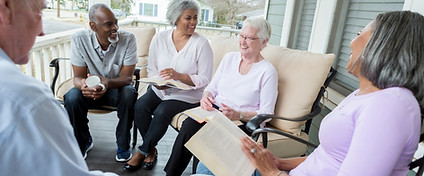What Is Assisted Living?
Assisted living is a type of senior housing designed for older adults who need support with daily living activities but do not require full-time medical care like in a nursing home. Residents typically live in private or semi-private apartments within a community setting, allowing them to maintain a sense of independence while having access to support whenever it’s needed.
These communities combine housing, personal care, and health services in a safe and comfortable environment. Caregivers are available 24/7 to provide assistance, respond to emergencies, and help residents manage their daily routines. Assisted living emphasizes promoting independence, dignity, and social engagement, making it a popular choice for seniors who want support without giving up their autonomy.
Benefits of Assisted Living
Assisted living communities offer numerous emotional, social, and physical benefits that can enhance the quality of life for seniors.
These benefits often include:
-
24/7 access to trained caregivers – Immediate assistance during health concerns or emergencies brings peace of mind.
-
Safe and secure environment – Buildings are designed with accessibility in mind, featuring ramps, grab bars, and emergency alert systems.
-
Social engagement – Residents can form new friendships and avoid isolation through shared meals, activities, and community events.
-
Maintenance-free lifestyle – Chores like cleaning, cooking, laundry, and home repairs are handled by staff, allowing residents to focus on hobbies and relaxation.
-
Healthy, balanced meals – Nutritious meals prepared by chefs promote better health and remove the stress of cooking.
-
Personalized care plans – Support is tailored to individual needs and regularly updated as care requirements change.
-
Opportunities for independence – Residents are encouraged to remain as independent as possible while having help close by when needed.
-
Peace of mind for families – Loved ones can rest easy knowing that their family member is safe, supported, and living in a vibrant community.
Assisted living provides a supportive environment where seniors can maintain their independence, stay socially connected, and receive care when they need it.

Emotional Benefits of Assisted Living
When families consider assisted living, the focus is often on physical care—help with bathing, meals, medications, and safety. But beyond the practical support, assisted living provides important emotional and mental health benefits that can significantly improve a senior’s quality of life. Here’s a closer look at how these communities can help seniors and families feel more secure, connected, and at peace.

Social Benefits of Assisted Living
When families think about assisted living, the first things that come to mind are usually personal care, safety, and medical support. While these are critical, the social side of assisted living is often just as valuable—and sometimes even more life-changing. For many older adults, the move to assisted living means entering a community filled with connection, friendship, and engagement, which can dramatically improve emotional, mental, and even physical well-being.

Physical Benefits of Assisted Living
When families think of assisted living, the first thing that often comes to mind is help with daily care tasks. But beyond assistance, these communities provide important physical benefits that support seniors’ health, safety, and overall well-being. By combining professional care with a safe and engaging environment, assisted living helps older adults maintain strength, mobility, and independence for as long as possible.
Signs It May Be Time for Assisted Living
It can be difficult to know when an aging loved one may need more support than can be provided at home. Often, changes in their physical health, mental well-being, or daily routines can signal that it’s time to explore assisted living options.
Look for the following common signs of decline or increased care needs:
-
Declining personal hygiene – Wearing the same clothes for days, not bathing regularly, or neglecting grooming.
-
Unexplained weight loss or poor nutrition – Skipping meals, spoiled food in the fridge, or noticeable weight changes.
-
Frequent falls or mobility issues – Trouble walking, balance problems, or injuries from falls around the home.
-
Difficulty managing medications – Missing doses, taking too much, or confusion about prescriptions.
-
Neglected home upkeep – Clutter, dirty dishes, unpaid bills, or unsafe living conditions.
-
Memory loss or confusion – Getting lost, forgetting familiar people, or showing signs of cognitive decline.
-
Social isolation – Withdrawing from friends and activities, or showing signs of loneliness or depression.
-
Increased caregiver stress – Family members feeling emotionally or physically exhausted, which can affect their own health.
If you notice several of these warning signs, it may be time to have an open and supportive discussion about assisted living. It’s best to involve your loved one early in the decision-making process, rather than waiting for a crisis like a fall or hospital stay. Planning ahead helps ensure a smoother transition, gives your loved one more choice in where they live, and reduces the emotional stress for everyone involved.

AGING PARENTS

CAREGIVER SUPPORT
Let Our Care Assessment Guide You
Discover the best care options for your loved one.
Our free assessment tool helps you understand what type of support your loved one may need. In just a few minutes, you’ll receive:
-
Personalized care recommendations
-
Expert advice tailored to your situation
-
Clear next steps for moving forward
Start your journey with confidence — because the right care begins with the right guidance.
How to Talk to Your Loved One About Assisted Living
Assisted Living Services and Features
Helping seniors live active, comfortable, and worry-free lives.
Assisted living communities offer a supportive and social lifestyle for older adults who need help with daily activities while still valuing their independence. These communities are designed to reduce the burden of everyday tasks so seniors can focus on what they enjoy most—spending time with friends, pursuing hobbies, and maintaining their well-being.
Residents receive personalized care tailored to their specific needs, with services that often include help with mobility, medication management, personal hygiene, transportation, and more. Alongside this support, assisted living communities also provide housekeeping, laundry, apartment maintenance, and delicious chef-prepared meals.

Personal Care
Trained staff assist residents with essential daily tasks such as bathing, grooming, dressing, and toileting. This support ensures seniors remain clean, comfortable, and confident while preserving their dignity.
By offering these services, assisted living communities ensure seniors receive the care, comfort, and social engagement they need to thrive. Families gain peace of mind knowing their loved ones are supported in a safe, vibrant, and well-maintained environment.

SERVICES
SERVICES

AMENITIES

SERVICES
AMENITIES
Assisted Living vs. Other Types of Senior Living
Assisted living is a popular and growing choice for seniors who want support with daily activities while maintaining independence. When exploring senior care options, it’s important to understand that different types of senior living offer varying levels of support and services.
Unlike nursing homes, assisted living does not provide full medical care. If your loved one has a complex or progressive health condition, a nursing home or higher level of medical care may be more appropriate.
At A Home With Care, we help families navigate these options so you can choose the best fit for your loved one’s needs.
Assisted Living Costs and Payment
Assisted living costs can vary widely depending on several factors, including location, apartment size, and the level of personal care required. Communities may also follow different pricing models — some offer all-inclusive packages that combine housing, meals, and care services into a single monthly fee, while others use an à la carte structure, charging separately for individual services based on each resident’s needs.
Typically, the base fee for assisted living includes essential services such as:
-
Rent and basic utilities
-
Daily meals and snacks
-
Housekeeping and maintenance
-
Transportation to medical appointments
-
Social, wellness, and recreational activities
These services ensure residents have a safe, comfortable living space and opportunities to stay active and engaged.
However, certain amenities and activities may come at an additional cost. Families should also plan for extra fees that are not usually part of the base rate, which may include:
-
Assistance with personal care (bathing, dressing, grooming)
-
Medication management
-
Internet, cable, and phone services
-
Laundry and linen service
-
On-site beauty and barber services
-
Pet fees for residents with companion animals
-
Special outings, events, or premium amenities
Because costs and services can differ significantly from one community to another, it’s essential to ask for a detailed breakdown of what is included in the monthly fee and which services are billed separately. This helps families make a well-informed decision that fits both their care needs and their budget.

COST
How Much Does Assisted Living Cost? A State-by-State Guide

How to Pay for Assisted Living: A Comprehensive Guide

VA Benefits for Assisted Living:
A Comprehensive Guide for Veterans

Does Medicaid Cover Assisted Living? What Families Need to Know
Touring and Moving Tips
Finding the right assisted living facility for your loved one can feel overwhelming, but visiting communities in person can help you make an informed choice. Touring lets you:
-
See the building and overall cleanliness
-
Observe how staff interact with residents
-
Try a meal and join in on activities
-
Talk to current residents about their experience
Tip: If an in-person visit isn’t possible, many assisted living facilities offer virtual tours.
One effective strategy is to tour several communities on your own first, then bring your parent to your top two favorites. This way, you can focus on communities most likely to appeal to them.
Once you’ve chosen a community, staff may connect you with move managers who can coordinate the move and even help remove boxes after unpacking. If moving day feels overwhelming, consider hiring professionals who specialize in senior transitions to ease the stress.

AGING PARENTS
Does Medicaid Pay for Assisted Living?
Senior Living for Couples:
Finding the Right Home at the Right Price
For many older adults, moving into senior living isn’t just about care—it’s about staying together. Couples want a community that supports their health, lifestyle, and budget, while also preserving the comfort of living side by side.
Choosing the Best Assisted Living Facility: Essential Questions to Ask
Finding the right assisted living facility is about far more than location or monthly cost—it’s about ensuring your loved one will feel safe, comfortable, and genuinely cared for every single day. A well-chosen community can provide the right balance ...
Moving to Assisted Living Checklist: What to Do, What to Bring, and What to Leave Behind
Moving to assisted living is more than just a physical relocation—it’s a major life transition for seniors and their families. Planning ahead, organizing belongings, and understanding what to bring (and leave behind) ...
Assisted Living Transition Tips for Families and Parents
Moving a parent into assisted living is one of the most significant changes a family can experience. It’s a step that often brings relief, knowing your loved one will receive the care and support they need, but it can also stir up strong emotions ...





















